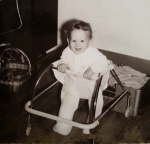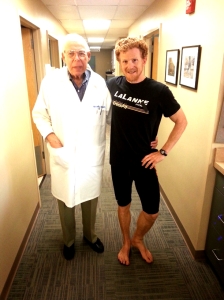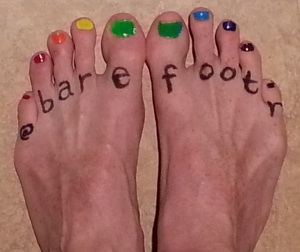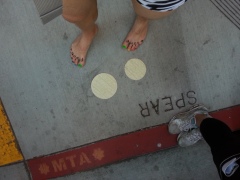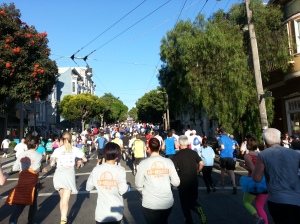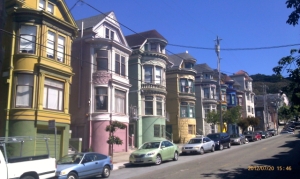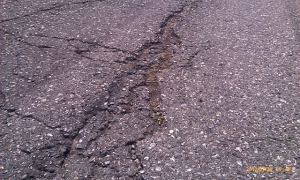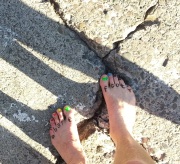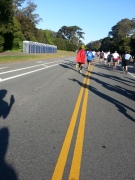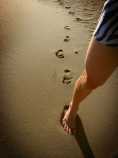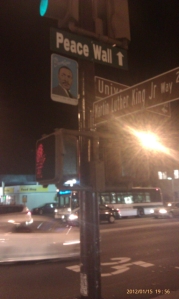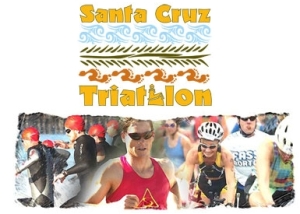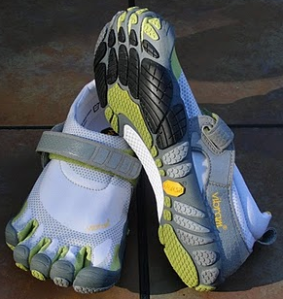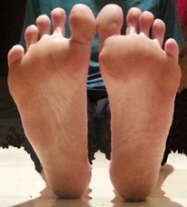5 reasons to wear or train in minimal (or no) shoes
 Vibram provided a nice summary of the benefits of wearing/training in their shoes. All of their points apply equally well to other minimalist shoes, with increasing applicability as you get closer to barefoot.
Vibram provided a nice summary of the benefits of wearing/training in their shoes. All of their points apply equally well to other minimalist shoes, with increasing applicability as you get closer to barefoot.
- Strengthens muscles in feet and lower legs.
- Improves range of motion in ankles, feet, and toes.
- Stimulates neural function. Important to balance and agility.
- Eliminates heel lift to align the spine and improve posture.
- Allows the foot and body to move naturally, which just feels good.
About Nerves
Point #3 in the above list comes from the closer connection you have with the ground permitting you to feel more detail in the terrain you’re walking/running on and transmitting more accurate body positioning info from your feet to your brain. Turns out our feet are jam packed with nerve endings:
The sole of your foot has over 200,000 nerve endings in it, one of the highest concentrations anywhere in the body. Our feet are designed to act as earthward antennae, helping us balance and transmitting information to us about the ground we’re walking on. (From “You Walk Wrong,” New York Magazine, 28 April 2008)
For a good demo of these nerve endings, have a friend run their fingers up the bottom of your foot, then compare that to doing the same thing on your knee. HUGE difference.
Wearing shoes for most of your life causes these nerve endings in your feet to dial up their sensitivity, essentially trying to ‘feel through’ your footwear. When you start going minimal, your hypersensitive feet will suddenly find themselves awash in ‘new data’ — and they will likely complain about it.
When you go to a movie theatre (or sit in a dark room for a couple of hours) and then walk out into bright daylight, your eyes hurt and it’s painful to see, but after a minute or so they adapt. An analogous thing happens with your feet when you suddenly start going minimal or barefoot after taking your feet out of the confinement of your shoes. Because your feet have been protected for so long, the adaptation process is correspondingly longer.
But the amazing thing is: you don’t really lose any sensitivity. Once the sensory nerves in your feet re-calibrate to being barefoot or minimally shod, you can still feel all the small random bits on the ground that you step on — they just don’t bug you so much.
Caveat Cursor
If you are are runner (“cursor” in Latin) these benefits also come with risks as you start increasing the duration and/or intensity of your workouts in minimal (or no) shoes. There’s a natural tendency to do too much too soon because, as your feet and legs begin adapting, it “just feels good” (Vibram’s point #5).
Coming from the comfy shoe world, it takes a long time to build up the strength in your feet and lower leg musculature & connective tissue required to tolerate running in minimal footwear. So keep most of your runs in your regular shoes and use the minimal shoes just occasionally (once per week max) for the first month or two, and ramp up gradually from there.
And as usual, get clearance from your doctor before starting an exercise program or making a major change to your existing program.
Resources
There is a growing array of online resources for people interested in getting into minimalist or barefoot running, many of which you can find on the blogroll on the right. Here are a couple of good ones to get you started:
I have a (barefoot) dream…
I did a track workout on Martin Luther King Jr. Day (consider this post part of my community service ;)). The workout was differentiated for long and middle distance runners. Since I fall somewhere in between, I decided to do a mix.
I also decided to run with mix of different footwear (as I sometimes do), running part of the workout in VFFs (TrekSport) and part barefoot. There was a total of 5k worth of speed in my workout, broken down as follows:
- 3000m in VFFs as 3 x 1000m at 5k speed with 400m jog rest,
- then:
- 2000m barefoot as 5 x 400m at 1 mile speed with 200m jog rest + 30s
My training has been a bit spotty of late (holidays), but am hoping to qualify as a seeded/sub-seeded runner for the Bay2Breakers this year after failing to do so last year. (Btw, I’m planning to run B2B barefoot again, regardless of my seeded or un-seeded status.)
My times at today’s workout:
- 1000’s: 3:52, 3:51, 3:57
- 400’s: 1:28, 1:27, 1:26, 1:26, 1:25
So I was definitely starting to flag by my last 1000 (which I did in VFFs) but managed to slightly descend the 400’s (which I ran barefoot). I attribute the relatively stronger performance in the 400’s not to footwear choice, but mostly to a general lack of longer distance tempo work which revealed itself in the 1000’s.
How did my feet do?
After taking off the VFFs, the rubberized surface of the track initially felt a bit rough, but after the first 200m it was no problem. The added feedback from my feet was welcome and provided some positive stimulation to my leg speed — a good demonstration that though VFFs are minimal, they are still a big leap from no shoes at all.
My feet have come a long way from last August when I did a similar workout (though shorter total distance) and fried my dogs good. The cooler track surface tonight probably helped (50F and no sun vs. ~80F at noon in Aug), but I don’t think that was a major factor.
Most of the heat your feet experience during fast barefoot running is due to frictional forces of foot strike rather than from the temp of the surface you’re running on. With time, your soles will be able to tolerate more of this friction, but be patient (I’m currently at my 2 year mark in doing speed workouts in minimal footwear).
Highly recommended après barefoot run activity: take a few laps on cool, evenly-surfaced grass or the beach (if you’re near one). The inside of the track is the perfect spot (or Ocean beach post-B2B).
For the curious, here’s how the soles of my feet looked after this track workout (as-is, pre-washing):
Regarding the issue of surface & air temperature: Here in the moderate SF Bay area, temperature isn’t usually much of a factor, but in hotter/cooler parts of the country, running surface temp and air temp can be a major factor. Choose the optimal time of day to run if you live in such places and want to go barefoot — or just keep the VFFs/sandals on until the weather cooperates!
I have a (barefoot) dream…
With due respect and homage to the great Dr. King, one can imagine an alternative rendition of his famous quote, geared toward a minimalist footwear crowd:
I have a dream that all people will one day live in a nation where they will not be judged by what they wear (or don’t wear) on their feet but by their commitment to fitness. I have a dream today…
Triathlon, barefoot-style
I competed recently in an olympic distance triathlon where I relied on minimal footwear for the run leg of the 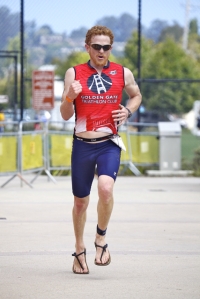 race. I’ve been wearing, training, and living in minimal (or no) footwear since early 2010 and doing a significant amount of barefoot running as well, but it’s not something I typically do in a competitive, race situation.
race. I’ve been wearing, training, and living in minimal (or no) footwear since early 2010 and doing a significant amount of barefoot running as well, but it’s not something I typically do in a competitive, race situation.
Why go minimal in a race situation?
Running in minimal footwear or barefoot is something I do primarily for orthopedic purposes, to reinforce good biomechanics and build strength in lower legs + feet + ankles (actually, it boosts everything from your hips on down). It also promotes better running efficiency, and this is something that can come in handy in an endurance event. On top of all that, it’s just plain fun!
So I thought, “Why not wear minimal footwear during a race? I could use the better biomechanics and efficiency there, too.” The only issue: can my feet & legs handle the sustained intensity? Well, you never know if you don’t try…
Results so far: impressive
Out of three triathlons I’ve done so far this season, wearing minimal shoes, I’ve podiumed in my age group in all three. In my most recent event (Tri Santa Cruz, olympic) where I wore the Luna Sandal “huaraches” (pictured above), I actually won my age group — something I’ve never done before in the 12 years I’ve been doing triathlons, large or small.
Other triathlons I’ve done this year include a 3rd place age group (AG) at the Treasure Island (sprint) wearing VFF Trek Sport, and 3rd place AG the Tiburon tri wearing the Luna Sandals. Such a close affiliation with podiums is not usual for me.
Some of my recent success can be attributed to experience & perhaps some field attrition, but I feel a significant amount of it is due to my choice of footwear in which I train. In these recent triathlons, my run leg has been the deciding factor, with some stronger swimming happening, too. Historically, my bike leg has been my strongest, but I’ve been doing less bike training these days focusing more on running. Also note that I’ve been riding the same bike for the past 10 years, so a change in cycling technology or training cannot account for my recent results.
But, one may wonder: would I have been as fast (or even faster) had I wore conventional shoes during these races? My guess is that I probably would have been about the same. However, I feel certain that my speed would have suffered had I not been training in minimal shoes like I’ve been over the past 1.5 years. My weekly run mileage this summer has been only ~10 miles (I’ve been laying low due to a foot injury in May-June — more on that later). A minimal footwear training session helps pack in more focused intensity into a shorter period of time — a precious commodity with wife + kids + job.
Choice of footware
There’s quite a few choices of sporty minimal shoes out there, and I credit Vibram Five Fingers with getting me into this business. I raced in the VFF Bikilas once or twice last season, and in the Trek Sport this year at the TI Sprint. Excellent shoes.
Lately though, I’ve become fond of Luna Sandals w/ elasticized leather laces which I wore at Santa Cruz and in Tiburon this year. Compared to VFFs they let your foot breath (important in summertime) and they are quicker to don (important for transitions in a triathlon situation).
T1: Stronger feet (& tougher skin) from barefoot running has permitted a faster run during T1 (swim-to-bike) which can entail a significant distance on city streets & other pavement (~0.5 mile at the Tri Santa Cruz). There’s no need for me to put on shoes to run to the bike transition, as some folks do. I can just gun it over the asphalt without a second thought. (Though usually I’m more cardio-limited and can’t run fast until my swimming engine shuts down).
Swimming: I know it may sound odd to say that barefoot running can help your swim stroke, but I feel there is a connection. My swim has improved significantly since I’ve been barefoot/minimal running, and I think part of this is from the improved leg strength due to the running. I’ve felt more leg endurance and kick strength in the pool, which helps improve body roll (I’ve also improved my core strength, which helps swimming mechanics as well).
A word of caution
As for handling the intensity of training/racing in minimal footwear, there’s always a new level of soreness after a race or a longer/harder workout that my body needs to adapt to. But I’ve been extremely patient and allowed for plenty of recovery time so that the little nagging pains don’t flare into major injuries. This is something I can’t recommend strongly enough to anyone tempted to follow my example. Being a triathlete & cross-trainer makes it easy to shift to a different sport when I need a break from running.
I’m racing in Santa Cruz again on Sep 25th. Stay tuned for details.
Updated 24 October 2011:
For the Santa Cruz olympic triathon on 9/25/11 I decided to run in my more conventional trainers (Asics Gel Tarther) to provide a comparison to my effort in the sandals from the previous month on what is virtually the same 10K run course. My time for the run leg was nearly identical (43:41 in sandals vs 43:45 in shoes) — in-line with my suspicion above that choice of footwear on race day doesn’t make a big difference (assuming adequate training). The SCT field on 9/25 was an order of magnitude more competitive than the 8/14 event where I won my AG, so no podium for me this time, though I did manage to hit my target of finishing in the top 10 of my AG.
Bearathlon Experiences
I also competed in the Cal triathlon club’s Bearathlon on Oct 8th, a race which has a penchant for hilly courses (which vary almost yearly). This year’s olympic course was held at Lake Temescal just after some heavy rains which had the effect of raising the bacterial count in the lake to unsafe levels, so they canceled the swim and made us run around the lake twice instead, turning this tri into a duathlon. I ran in the Luna Sandals for both run legs of the Bearathlon which featured copious vertical: the loop around the lake featured a big off-road hill (a little rocky) and the 10K run (mostly on streets) had close to 1K feet of total ascent — this after a bike course with ~2K’ of ascent.
Downhill Downer
Extensive downhill running was tough in the sandals since one cannot rely on rear foot striking to absorb the added impact when barreling downhill. The strap at the front of the sandal in between the big and 2nd toe was working overtime — the focussed pressure here was not something I was used to, primarily from a stability point of view, not abrasion (though the pressure was becoming annoying). Increased leg turnover (cadence) helped cope with the hills.
I survived the Bearathon and managed to podium once again (3rd among masters, 2nd AG). In this race, I’m sure I would have posted a faster run time with conventional shoes given all the hills (and a poorly marked turn on the run course which set me and #105 back by ~1/4 mile). So the minimal shoes deserve commendation here primarily for their training effect, and for scoring me some points among the collegiates. It’s not everyday that you get a told by someone half your age that what you did was “badass.” 😉
Bay To Breakers – Barefoot
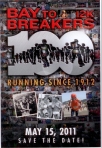
The centennial running of the Bay To Breakers 12K will take place in San Francisco this Sunday May 15, 2011. Last year, I ran it in my KSO’s, while carrying a pair of lightweight trainers as a back-up just in case my feet couldn’t take the full distance in the KSO’s. I had been using the VFF’s for about 5 months at that point and I knew that 7.5 miles would be pushing it. I made it the whole way at a decent but not killer pace for me (~7:30′ or 7:45′ miles), though last ~2 miles were tough.
This year I plan to up the ante. The plan is to run barefoot at least to the top of Hayes Street and tote a pair of VFF’s to don when my soles need a break. It’s not quite on par with Abebe Bikila, but I think it will be a fitting way to commemorate the 100th anniversary of this famous foot race.
I encourage other minimalist shoe runners doing the #B2B100 to join me in this challenge. If you do go bare, be extremely vigilant of random junk on the course — think safety first! If you’re interested in meeting up after the race, aim for letter “B” at the Footstock alphabet garden in Speedway Meadow around 9:30am. Take off your shoes so we can find each other!
Abebe Bikila – Barefooter wins 1960 marathon
Abebe Bikila represented Ethiopia sans shoes in the 1960 Rome Olympics and became the first black African to win gold. Truly inspirational. He ran barefoot because he was unable to find a comfortable pair of running shoes and he had been regularly training barefoot. There are some other videos here and here — the latter had close-up slow-motion of Abebe running, but it appears to have been pulled from YouTube :(.
According to the Wikipedia article he made the decision to go barefoot just a few hours before the race and had trained for the race barefoot. Ultimately he did it because, in his words, he “wanted the world to know that my country, Ethiopia, has always won with determination and heroism.”
In 2010, fifty years after Abebe’s historic win, Vibram released its Bikila model of VFFs, helping to bring Abebe-style running to the masses. Click on image for a good review of the Bikilas.
Do you think we’ll ever see another barefoot Olympic marathoner? Perhaps a VFF-er?
Barefoot running
This post originally appeared in my blog in May 2010 and is a good summary of my initial experiences with VFFs. It also has an assortment of barefoot running links.
I got some Vibram 5 Fingers (VFF) shoes at the end of December 2009 and during the past 4 months I’ve been experimenting with running in them, to get my feet wet in this barefoot running business that has been much in the news of late. (Technically-minded folks will note that if you’re wearing these shoes you’re not barefoot, but you’re pretty darn close.)
I’ll use this post to provide some background links as well as describe my first-hand experiences. I included a couple of self-photos of my KSO’s: the first shot was taken during the first week I had them, and the second was taken about 3 months later, after wearing them during the run portion of the Golden Bearathlon. It was a muddy 10K trail run and the shoes cleaned up nicely in the wash. I don’t do all my runs in these shoes now, but I’m gradually moving in that direction.
Goodbye Orthotics
Probably the most powerful thing I can say from my experiences would be this: Since I started running in the VFFs, I have dropped my dependency on the custom orthotics that I’ve worn religiously for the past 15 years. In 1995, I had the orthotics made and wearing them greatly reduced my running injuries; basically I never did a run or went anywhere without them since ’95.
However, this has all changed since I’ve been running in the VFFs. These minimalist shoes are basically socks with some rubber on the soles — you cannot wear orthotics in them (well, you could, but it would feel very clunky and biomechanically unnatural). So I’ve stopped wearing the orthotics whenever I run, even when I run with regular, heavy-soled running shoes. I have not encountered any chronic running injuries since, and I no longer need to worry about where my orthotics are at all times (though I still prefer them if I have to do a lot of walking/standing, e.g., spending the day at Disneyland).
Gradual Adaptation
I’ve been running for fitness for the past 30+ years wearing conventional, cushy, industry-standard running shoes (usually something neutral like the Asics Gel Nimbus). Since running in the VFFs, it’s become apparent how woefully undertrained my calves were. By promoting a rear-foot strike (RFS) running form (i.e., landing initially on your heel, then rolling off the toe), standard running shoes effectively shield the calves from doing much work.
Before I acquired the VFF shoes, I spent 1-2 months working on a more fore-foot strike (FFS) running style using my traditional thick-heeled running shoes. This included some barefoot running on grass. I experienced lots of calf soreness during this period, especially after harder, faster training sessions. It took a while to switch my running form from RFS to FFS — I’d say a solid two months before it started to feel natural. I was lucky enough to get some great coaching from local track coach Steve Kraft to help me learn this new running style, which has more elements to it than just foot strike.
Once I got the VFFs and started doing faster and longer runs in them, my calves experienced even more soreness. I took it fairly easy, running only on soft surfaces (like trails or rubberized tracks) once every 1-2 weeks in the VFFs, using my standard cushy shoes for all other runs. The first time I did a mile’s worth of total speedwork in the VFFs, my calves were sore for a week, hard to walk or even bike for the first few days after. Additional feedback on my VFF running form from other experienced runners revealed that I was running too much on the balls of my feet, putting excessive strain on my calves. With practice, I was able to adopt a more neutral foot strike.
Morals:
- Be extremely gradual in adding speed and mileage to your VFF runs.
- Get some feedback from a running coach or experienced runners.
Update, 19 May 2010: Here are a few additional thoughts and tips on barefoot or minimalist shoe running:
Are they comfortable?
This is the most common question I get from random, inquisitive strangers that notice my VFFs when I’m out in public with them. In short, yes they are quite comfy when just lounging around in them. But note that they give about the same degree of support as a pair of socks, so spending a full day standing/walking around in them on pavement will really wipe you out the first time you try it. About two months after I started wearing them I spent two back-to-back days wearing them while visiting Disneyland with my family — this was definitely overdoing it.
The lightness of being barefoot
The lack of weight at the end of your legs while running is quite addicting. It leads to much less torque on your overall leg motion and permits a more natural gait and more efficient cadence. The low weight and lack of bulk of the VFFs also makes them highly portable. I actually biked with them in a fanny pack, along with a bunch of other gear, for the entire MS150 bicycle ride from Houston to Austin in April 2010. They were my après-cycling footwear.
Running shoe built-into your legs
Barefoot-style running trains your leg muscles, feet, joints, and connective tissues to learn to do more of the shock absorbtion that we’ve been delegating to conventional running shoes. Running barefoot or with minimalist shoes like VFFs trains your legs to acquire those shock absorbing powers, essentially building a running shoe into your body. Transitioning from a RFS to a FFS style and adapting to minimalist shoes feels like it has given my running legs another “gear” that I can employ regardless of my footwear. It is a more muscular style of running where the legs learn how to absorb the shocks of running and even obtain some elastic recoil from each foot strike. With a RFS running style where the shock of each footstrike is dissipated via the heel, shocks are absorbed primarily via the shoe plus your skeleton, which dissipates the impact energy and provides no recoil opportunity (and can in fact lead to loss of forward momentum via braking).
Easy does it
As Barefoot Ken Bob warns: Don’t do too much too soon! There’s a strong temptation to overdo it, especially as your feet and legs start adapting. But it really takes quite a bit of time to fully adapt to a barefoot or minimalist shoe running style. The transition is more difficult and longer for folks (such as myself) with a long history of RFS style running.
When starting out, pick the smoothest surfaces you can (such as grass, astroturf, or a rubberized track). Our soft, modern feet take a major pounding when running and bruise/blister incredibly easily. The first time I stepped on a rock the wrong way with the VFFs I got a bruise on the ball of my foot that was tender for several days, and even after 5 months of using the VFFs, I still get hot spots and bruises when I push the pace or terrain (though my feet now recover much faster). Over time, you will learn how to run more gently and your feet will toughen up, but it takes months (maybe up to a year), and you still must always be mindful of your terrain. The plus side of having barefoot/minimalist shoe running is it provides great feedback from the running surface that is otherwise masked by standard heavy-soled running shoes. Especially when running on trails, each footstep is unique, giving you a deeper sense of connectedness with your environment and increasing the mental stimulation of running. It can be very reflexology-like. Run barefoot for best results here (feet and terrain-permitting).
Variety is the spice
Even if you are skeptical about the benefits of barefoot/minimalist shoe running and think it’s yet another passing fad, you’ve got to admit that it is way different than what the running shoe industry has been doing for the past 30+ years and it gives a runner something new to play with. Use it to inject variety and shake up your routine, get out of your comfort zone, and keep your workouts from becoming stale. This all helps to keep you motivated, which is key to long-term success in sticking with your fitness goals.
Foot stretches.
Stretching helps rejuvenate tired feet, especially when walking/standing in them for long periods. Here are some stretches, all of which can be effectively performed while wearing VFFs (but not with standard shoes!):
- Flex and point toes, alternating and holding the stretch and point for ~5 seconds each.
- Foot circles or “alphabets” where you trace each letter of the alphabet with your foot (caps or cursive).
- Gripping with toes. Imagine you are trying to grab a ball with your toes. This motion is almost like pointing your toes while dorsiflexing. ‘Grip’ and hold for a few seconds. Relax by dorsi-extending and fanning toes.
- Top of toes on ground. Can be done when standing or sitting. Standing on one leg, bend other knee and point toes behind you, attempting to touch the top of foot on the ground behind you. Hold and breathe.
- Foot massage. While sitting, cross on leg and work one foot at a time. Use your thumb to massage the plantar fascia. Also massage the lower achilles tendon area around the sides of the heel.
Use powder
Applying talcum powder on the inside of the VFFs helps a lot in fighting microbial odors and easing foot entry. I like Burt’s Bees; Dr. Scholl’s also sells powders with antimicrobial additives. Washing the VFFs with a powdered detergent once/week on a gentle or ‘easy care’ cycle then air drying keeps them in good shape. Just throw them in with your other laundry.
Additional Links:
- Chris McDougall – Born To Run author, kicked off the most recent VFF/barefoot running craze.
- The Roving Runner Goes Barefoot (NYTimes, 5 Oct 2009)
- History/motivation behind writing of the book “Born to Run” (YouTube)
- Appearance on John Stewart (Aug 2009)
- Talks about wearing vibram five fingers(15 Jun 2009)
- Chris McDougall’s informal Google talk (16 Oct 2009)
- Lieberman et al. Nature paper, Jan 2010: “A comparison of the biomechanics of habitually shod versus habitually barefoot runners suggests that running barefoot is not only comfortable but may also help avoid some impact-related stress injuries.”This begat a flurry of other reports appearing in Jan 2010:
- The Barefoot Professor Daniel Lieberman (YouTube video, Harvard University study, 1/27/10)
- Study: Humans were born to run barefoot (NPR, 27 Jan 2010)
- ScienceDaily coverage of Lieberman study (ScienceDaily, 1 Feb 2010)
- Running Shoes May Cause Damage to Knees, Hips and Ankles, New Study Suggests (Science Daily, Jan. 6, 2010)
- Study: Running Shoes Could Cause Joint Strain (LiveScience, 12 Jan 2010)
- Running Shoes Changed How Humans Run (LiveScience)
- Wikis and Blogs:
- Barefoot running icons:
- Pose Running method:
- Pose technique originated in the 1970’s by Dr. Nicholas Romanov.
- Heel striking is way bad, according to the Pose experts.
- Opinions on barefoot running:“I would like to mention that barefoot running is not a panacea for avoiding running problems, it is not an automatic guarantee of running proper. It is just another tool for learning to run proper, because of more elements of a proper running technique present there than anywhere else.”
- Pose advocates claim that their method applies to any sport.
- Other links:
- Wiggling Their Toes at the Shoe Giants(29 Aug 2009)
- Is it the shoes? It’s gotta be the shoes. (YouTube comparison no shoes and with shoes)
Welcome!
Barefootr is all about helping you maximize your barefoot experience of the world; for sharing these experiences, and finding advice about safely exploring the world barefoot or in minimalist footware.
This website is just getting started. In the meantime, tune into the twitter feed: http://twitter.com/barefootr
